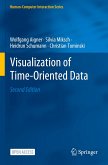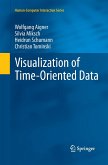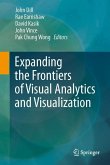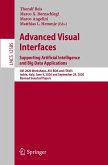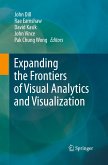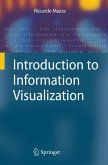This is an open access book.
Time is an exceptional dimension with high relevance in medicine, engineering, business, science, biography, history, planning, or project management. Understanding time-oriented data via visual representations enables us to learn from the past in order to predict, plan, and build the future.
This second edition builds upon the great success of the first edition. It maintains a brief introduction to visualization and a review of historical time-oriented visual representations. At its core, the book develops a systematic view of the visualization of time-oriented data. Separate chapters discuss interaction techniques and computational methods for supporting the visual data analysis. Many examples and figures illustrate the introduced concepts and techniques.
So, what is new for the second edition? First of all, the second edition is now published as an open-access book so that anyone interested in the visualization of time and time-oriented data can read it. Second, the entire content has been revised and expanded to represent state-of-the-art knowledge. The chapter on interaction support now includes advanced methods for interacting with visual representations of time-oriented data. The second edition also covers the topics of data quality as well as segmentation and labeling. The comprehensive survey of classic and contemporary visualization techniques now provides more than 150 self-contained descriptions accompanied by illustrations and corresponding references. A completely new chapter describes how the structured survey can be used for the guided selection of suitable visualization techniques.
For the second edition, our TimeViz Browser, the digital pendant to the survey of visualization techniques, received a major upgrade. It includes the same set of techniques as the book, but comes with additional filter and search facilities allowing scientists and practitioners to findexactly the solutions they are interested in.
Time is an exceptional dimension with high relevance in medicine, engineering, business, science, biography, history, planning, or project management. Understanding time-oriented data via visual representations enables us to learn from the past in order to predict, plan, and build the future.
This second edition builds upon the great success of the first edition. It maintains a brief introduction to visualization and a review of historical time-oriented visual representations. At its core, the book develops a systematic view of the visualization of time-oriented data. Separate chapters discuss interaction techniques and computational methods for supporting the visual data analysis. Many examples and figures illustrate the introduced concepts and techniques.
So, what is new for the second edition? First of all, the second edition is now published as an open-access book so that anyone interested in the visualization of time and time-oriented data can read it. Second, the entire content has been revised and expanded to represent state-of-the-art knowledge. The chapter on interaction support now includes advanced methods for interacting with visual representations of time-oriented data. The second edition also covers the topics of data quality as well as segmentation and labeling. The comprehensive survey of classic and contemporary visualization techniques now provides more than 150 self-contained descriptions accompanied by illustrations and corresponding references. A completely new chapter describes how the structured survey can be used for the guided selection of suitable visualization techniques.
For the second edition, our TimeViz Browser, the digital pendant to the survey of visualization techniques, received a major upgrade. It includes the same set of techniques as the book, but comes with additional filter and search facilities allowing scientists and practitioners to findexactly the solutions they are interested in.
Fernando Berzal - ACM Computing Reviews 16 July 2012
There is no doubt about the importance of visualization in data analysis, whether for examining the unknown and suggesting novel approaches to explore, for confirming yet-to-be-proved hypotheses and abandoning future dead ends, or just for supporting someone's ideas with visual aids in a presentation. In most situations, the data being analyzed includes a temporal dimension whose proper treatment might boost (or bust) the resolution of a given data analysis task. Hence a systematic treatise on the visualization of time-oriented data is welcome.
Four researchers from Vienna University of Technology in Austria and the University of Rostock in Germany have compiled this extensive catalog of visualization techniques where the temporal dimension plays a major role. Their book contains one-page descriptions of 101 different ways to represent the temporal dimension of data in two or three dimensions. The catalogued techniques include literally dozens of different ways to plot time series. Some have been devised for highlighting parallelisms among different time series when analyzing multivariate data, whereas others were designed for bringing the periodic nature of time into the spotlight. Many of them have been incorporated into data visualization tools for making efficient use of the limited screen real estate and some allow for the visualization of spatiotemporal data, where appropriate. The page devoted to each technique is beautifully illustrated with a relevant diagram or screen shot. Each page also includes a concise textual description of the rationale behind the technique under analysis and, almost as a footnote, the most pertinent bibliographic reference (in rare occasions, a handful of them).
The survey of visualization techniques comprises the second half of this nicely illustrated book. The first half tries to cover the intellectual foundation behind the visualization techniques themselves. A short introduction familiarizes us with the reasons behind the use of data visualization tools, that is, why we might need them and how they can support interactive data analysis. The introduction also describes how they are designed as visualization pipelines and the different reference models that have been proposed to describe their essence. A pleasant historical account of the evolution of the pictorial representation of time, from statistical charts to different artistic movements, paves the way for a more technical overview of how time is modeled in information systems to "reflect the phenomena under consideration and support the analysis task at hand."
The visualization aspects are covered first, followed by the interaction and analytical support that current data visualization tools provide. With respect to data visualization, techniques are structured around three simple questions that also help categorize the 101 techniques in the survey: What? Why? How? The data to be represented (what) and the user tasks that must be supported (why) determine the visual representation mechanism (how). Some examples are given to illustrate the proper solution of data visualization problems, from ways to highlight the periodicity in temporal data to the different color- coding strategies that should be used to support different tasks (the same color scheme is not suitable for identification, localization, and comparison, for instance).
This book also includes a couple of chapters on features that every data visualization tool should support. The first of these chapters, on interaction, describes user intents, conceptual and technical considerations that should be taken into account, and methods such as direct manipulation, brushing & linking, or dynamic queries, as well as the use of event-based visualization. The second chapter, on analytics, merely touches the surface of a growing field, which deserves a much more elaborate treatment.
Iagree with the authors' plea for more effort on the integration of visual, interactive, and analytical methods for mining large and complex time-oriented data. For interactive data visualization tools, scalability issues are paramount if we want to study very long time series of large numbers of data in parallel. Newcomers to the field can certainly benefit from the authors' description of the general architecture of visualization tools, the considerations they recommend with respect to visualization and interaction techniques, and the coarse taxonomy of visualization techniques they propose to structure their survey of visualization techniques. Combined, these provide the conceptual framework that could serve as the starting point for the new research that could make the authors' plea a reality.
There is no doubt about the importance of visualization in data analysis, whether for examining the unknown and suggesting novel approaches to explore, for confirming yet-to-be-proved hypotheses and abandoning future dead ends, or just for supporting someone's ideas with visual aids in a presentation. In most situations, the data being analyzed includes a temporal dimension whose proper treatment might boost (or bust) the resolution of a given data analysis task. Hence a systematic treatise on the visualization of time-oriented data is welcome.
Four researchers from Vienna University of Technology in Austria and the University of Rostock in Germany have compiled this extensive catalog of visualization techniques where the temporal dimension plays a major role. Their book contains one-page descriptions of 101 different ways to represent the temporal dimension of data in two or three dimensions. The catalogued techniques include literally dozens of different ways to plot time series. Some have been devised for highlighting parallelisms among different time series when analyzing multivariate data, whereas others were designed for bringing the periodic nature of time into the spotlight. Many of them have been incorporated into data visualization tools for making efficient use of the limited screen real estate and some allow for the visualization of spatiotemporal data, where appropriate. The page devoted to each technique is beautifully illustrated with a relevant diagram or screen shot. Each page also includes a concise textual description of the rationale behind the technique under analysis and, almost as a footnote, the most pertinent bibliographic reference (in rare occasions, a handful of them).
The survey of visualization techniques comprises the second half of this nicely illustrated book. The first half tries to cover the intellectual foundation behind the visualization techniques themselves. A short introduction familiarizes us with the reasons behind the use of data visualization tools, that is, why we might need them and how they can support interactive data analysis. The introduction also describes how they are designed as visualization pipelines and the different reference models that have been proposed to describe their essence. A pleasant historical account of the evolution of the pictorial representation of time, from statistical charts to different artistic movements, paves the way for a more technical overview of how time is modeled in information systems to "reflect the phenomena under consideration and support the analysis task at hand."
The visualization aspects are covered first, followed by the interaction and analytical support that current data visualization tools provide. With respect to data visualization, techniques are structured around three simple questions that also help categorize the 101 techniques in the survey: What? Why? How? The data to be represented (what) and the user tasks that must be supported (why) determine the visual representation mechanism (how). Some examples are given to illustrate the proper solution of data visualization problems, from ways to highlight the periodicity in temporal data to the different color- coding strategies that should be used to support different tasks (the same color scheme is not suitable for identification, localization, and comparison, for instance).
This book also includes a couple of chapters on features that every data visualization tool should support. The first of these chapters, on interaction, describes user intents, conceptual and technical considerations that should be taken into account, and methods such as direct manipulation, brushing & linking, or dynamic queries, as well as the use of event-based visualization. The second chapter, on analytics, merely touches the surface of a growing field, which deserves a much more elaborate treatment.
Iagree with the authors' plea for more effort on the integration of visual, interactive, and analytical methods for mining large and complex time-oriented data. For interactive data visualization tools, scalability issues are paramount if we want to study very long time series of large numbers of data in parallel. Newcomers to the field can certainly benefit from the authors' description of the general architecture of visualization tools, the considerations they recommend with respect to visualization and interaction techniques, and the coarse taxonomy of visualization techniques they propose to structure their survey of visualization techniques. Combined, these provide the conceptual framework that could serve as the starting point for the new research that could make the authors' plea a reality.


